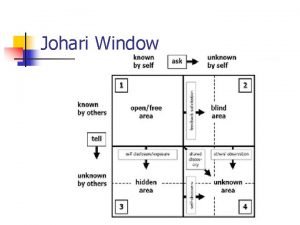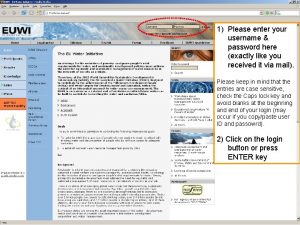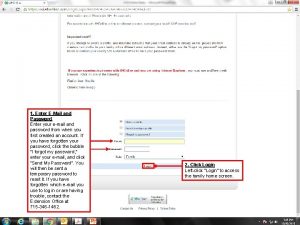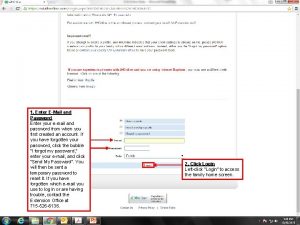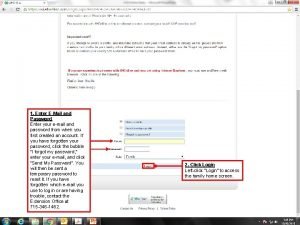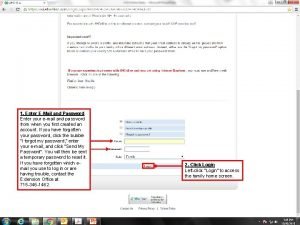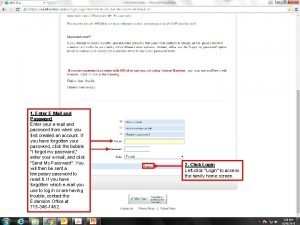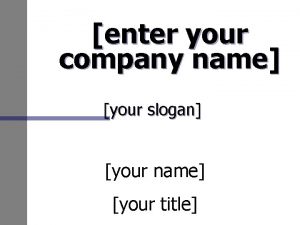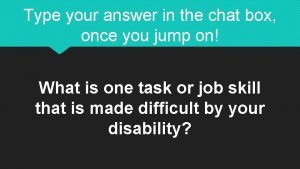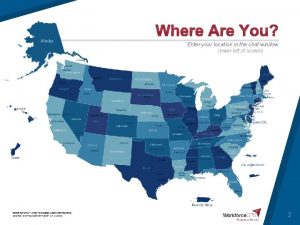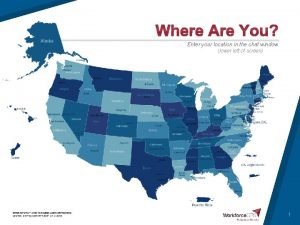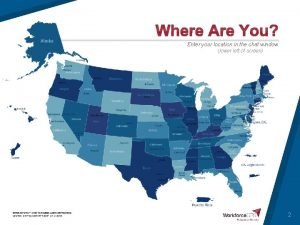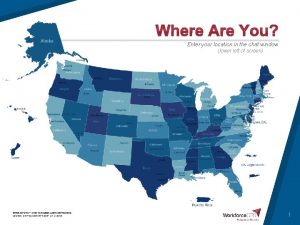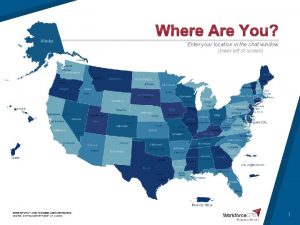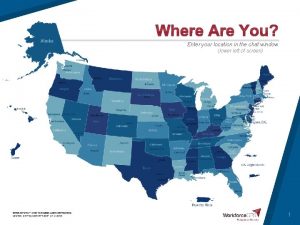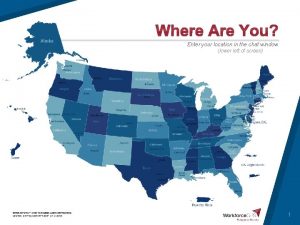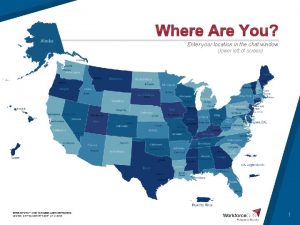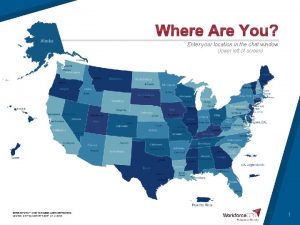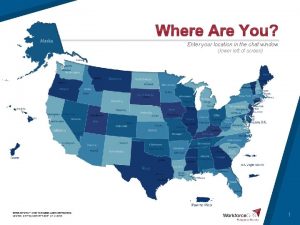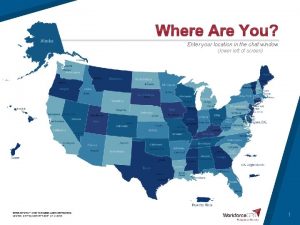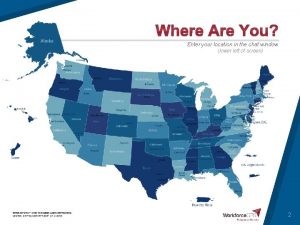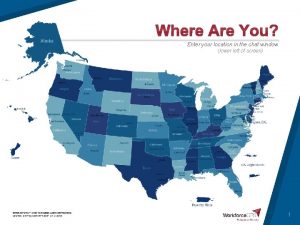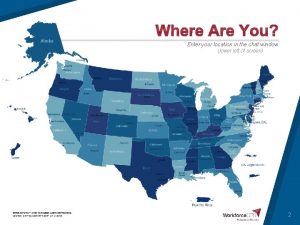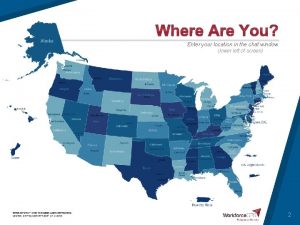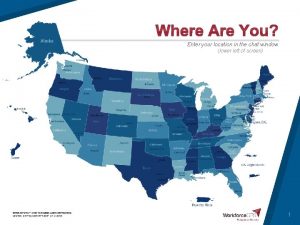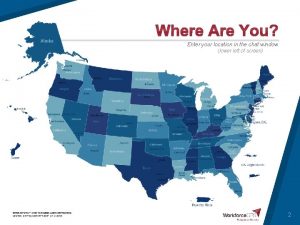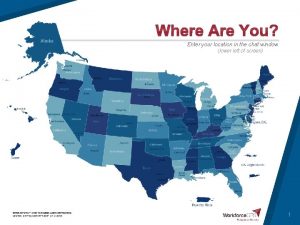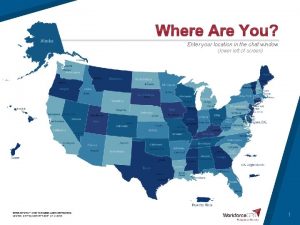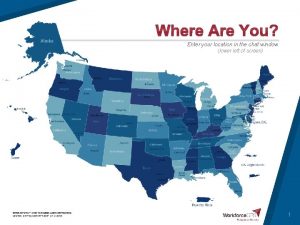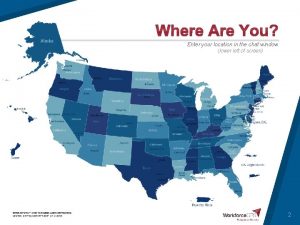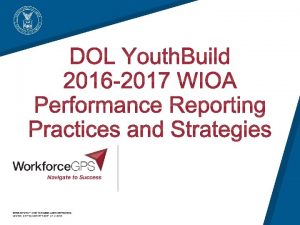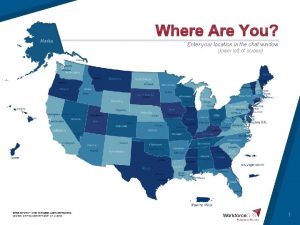Enter your location in the chat window lower




























- Slides: 28

Enter your location in the chat window (lower left of screen) 2


Workforce Analyst, H 1 -B Grants ETA, Division of Strategic Investments SWFI TA Senior Subject Matter Expert The Urban Institute SWFI TA Coach Mathematica Policy Research 4

Describe meaningful employer engagement and why it is important for SWFI grantees Discuss challenges to engaging employers and strategies for success Answer grantee questions about engaging employers to support SWFI participants’ career pathways 5

¡Meaningful employer engagement ¡Challenges to engaging employers ¡Strategies for success 6

Choose the answer that best reflects you (or your organization) 1. Daily 2. Weekly 3. Monthly 4. Quarterly 7

8

Spaulding and Martin-Caughey 2015 9

¡Learning the short and long term needs of local employers } Confirm skills and training requirements for middleand high-skilled jobs } Identify attainable wages for SWFI graduates } Shape training to meet employer needs } Inform participant decisions about career pathways in the local area 10

¡Reviewing training curricula with employers } Ensure that training adequately covers the technical skills specific to an industry or occupation } Incorporate soft skills that participants need to succeed in the workforce } Identify best practices for training to employers’ needs ¡Involving employers in classroom training or development of work-based learning activities } Build stronger employer connections to the program } Help participants gain knowledge of industries and employers } Open doors for program participants 11

¡Discussing employers’ staffing needs } Receive direct and early notification of job openings } Develop agreements that SWFI participants will be interviewed and, if possible, hired directly ¡Although used infrequently, agreements to hire can be linked to strong partnerships with employers (Spaulding and Martin-Caughey 2015) 12

¡Meaningful engagement with employers } Signal a higher level of program quality for both employers and job seekers } Gain access to employer networks to identify other potential employers } Gain access to job-seeker networks to recruit participants 13

Choose the answer that best reflects you (or your organization) Helping your SWFI team: 1. Understand the local labor market 2. Refine your program design 3. Provide information and skill-building opportunities to participants 4. Create pipelines for participant hiring 5. Enhance credibility and sustainability 14

15

¡Grantee staff time required to build, monitor, and sustain meaningful employer relationships ¡Employer staff time required to educate grantees about their needs, review and participate in training, and develop hiring plans ¡Grantees and employers may not be able to dedicate the right staff to these efforts 16

¡Information gap due to use of different terminology ¡SWFI programs may not know what questions to ask employers ¡Employers may not know how to communicate their needs to workforce programs 17

¡Employers may hire limited numbers at a time and may not need a hiring pipeline ¡Employers may be wary of working with SWFI target populations ¡Employers may not see the long-term benefit to investing in a SWFI program 18

Choose the answer that best reflects you (or your organization) 1. Meaningful employer engagement takes more time than our SWFI team has available 2. Our SWFI team and local employers do not communicate effectively 3. It is hard to find the right staff to be responsible for employer engagement 4. Employers do not understand how the SWFI program and participants can help them 19

20

¡Find employers that are a good match for the participants you are serving and the programs you offer } Are you training for jobs the employer has? } Is there a match in the scale and pace of hiring? } Are employers community minded? Do they seek volunteer leadership opportunities for staff? } Do they have the desire to invest in workers? } Can they provide growth opportunities and career pathways? 21

¡Develop a plan for engaging employers } Goals, benchmarks, timeline, elevator speech, meeting agendas, action items, responsible staff } Minimize employer burden through careful planning and ongoing communication ¡Tailor your approach to each employer } Consider a mix of email, telephone, and in-person contacts } Build rapport, sell your program, gain buy-in, describe reciprocity, identify next steps ¡Nurture employer relationships } Capitalize on momentum, send “thank you” emails, reiterate timeline/next steps, keep in touch, reciprocate } Track progress, create feedback loops, acknowledge and address problems when they arise 22

¡Build trust with employers so they know SWFI participants will have the technical and soft skills they need ¡Intentionally match participants to employers to maximize success ¡Expose employers to participants in non-hiring settings such as classes or social events 23

¡Ask existing employer partners to help your SWFI program connect with other local employers ¡Continue to nurture employer relationships— the trust your SWFI program builds with employers, and your ongoing ability to provide well-trained participants, helps build your credibility with new partners 24

§ Deeper involvement in certain program activities § Involvement in a broader range of program activities § Participation in workforce sector partnerships 25

Enter your questions in the chat window (lower left of screen) 26

¡Peer-sharing call in October—Look for an invitation from the SWFI mailbox ¡Regular coaching calls ¡Blog post on employer engagement with links to resources ¡Discussion board on employer engagement 27

SWFI@dol. gov

29
 Vận chuyển các chất qua màng sinh chất
Vận chuyển các chất qua màng sinh chất Pinakamahalagang bahagi ng teksto
Pinakamahalagang bahagi ng teksto Window width and window level
Window width and window level Johari window personality test
Johari window personality test Windows 7 inside out
Windows 7 inside out Window to window chapter 28
Window to window chapter 28 Tympanic antrum
Tympanic antrum Fro
Fro Window to window chapter 19
Window to window chapter 19 Please enter username and password
Please enter username and password Enter your state name
Enter your state name 1 enter your email
1 enter your email 1 enter your email
1 enter your email Enteremail
Enteremail 1 enter your email
1 enter your email 1 enter your email
1 enter your email Enter your text here
Enter your text here You and your mom enter a drawing with 3 different prizes
You and your mom enter a drawing with 3 different prizes Enter your company name
Enter your company name Enter your class
Enter your class Please type your questions in the chat box
Please type your questions in the chat box A cross country skier moves from location a
A cross country skier moves from location a Location planning management
Location planning management Lower your gaze quran
Lower your gaze quran Lower your gaze quran verses
Lower your gaze quran verses Give us your hungry your tired your poor
Give us your hungry your tired your poor Hát kết hợp bộ gõ cơ thể
Hát kết hợp bộ gõ cơ thể Slidetodoc
Slidetodoc Bổ thể
Bổ thể



